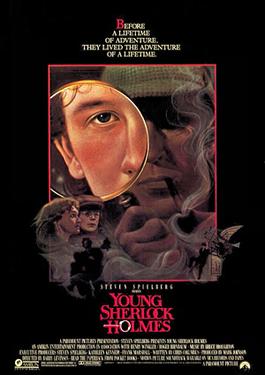With Sherlock Holmes currently quite prominent in our pop culture, and with me having watched J.J. Abram's attempt at an Amblin film a few weeks ago with Super 8, I saw this on Netflix and wondered how it escaped my attention when I was a kid. I remember seeing TV commercials for it, I remember my friends having talked about it, but I never saw it myself. It seems to be mostly forgotten when it comes to Amblin movies ("Amblin movies" pretty much means the films Spielberg produced via his company Amblin Entertainment in the 1980s). It's become a footnote in special effects history as it was the first film to feature a computer animated person.
That clip above is the scene in question. Our murderer kills by injecting people with a hallucinogen, and the resulting hallucinations literally frighten people to death. That priest is killed when he hallucinates a knight on a stained glass window coming to life and chasing him. The stained glass knight is the "computer animated person" in question. Animated by future Toy Story director John Lassetter, back when Pixar was still ILM's computer animation R&D lab. But I digress.
Young Sherlock Holmes is an imaginary tale set in world of Sherlock Holmes. And they make that point clear. The film both begins AND ends with a disclaimer pretty much saying, "Yeah, we know this deviates quite heavily from established Holmes canon, but please allow us this flight of fancy." It's a simple "What If?" tale, asking what if a teenage Holmes and Watson first met and embarked on their first case in one of those classic British boarding schools.
The film opens with our young Watson -- looking very much like a pudgy Harry Potter -- first arriving at the boarding school, and meeting his bunkmate, star pupil Sherlock Holmes. We see that Holmes' legendary powers of deduction are already in full swing, and with Holmes being the upperclassman, he quickly takes the younger Watson under his wing and shows him around the school. We meet Professor Rathe, the school fencing instructor whom Holmes has a kinship with, and Rathe frequently chides Holmes for allowing his emotions to get the better of him. There's Professor Waxflatter, a retired headmaster who still has a workshop on campus, and Holmes regards him as a mentor. Indeed, Waxflatter's workshop on campus soon becomes an early model for Holmes' flat on 221B Baker Street. And there's Waxflatter's niece Elizabeth, whom Holmes is madly in love with.
An emotional Holmes who's madly in love...doesn't sound like the character we all know and love these days. When screenwriter Chris Columbus first hatched the tale, he sought to understand why Holmes grew up to be so emotionally detached and absorbed in his work. The solution he came up with was a childhood heartbreak encouraged Holmes to seek solitude.
Chris Columbus wrote this, who went on to direct Home Alone, Mrs. Doubtfire, and the first two Harry Potter films. And watching this, you can tell he was always the ideal choice for Harry Potter. Maybe it's the boarding school setting. Maybe it's just the accents. Maybe it's because Holmes has a Draco-like rival classmate named Dudley. Hell, maybe it's because young Watson looks like a pudgy Harry Potter, but you can't help but get a strong Harry/Ron/Hermione vibe from Holmes/Watson/Elizabeth.
Anyway, back to the plot. When Professor Waxflatter soon turns up dead, the latest murdered by those hallucinogenic darts, Holmes vows to bring his mentor's killer to justice. The game is afoot as Holmes, Watson, and Elizabeth soon scour the streets of London, doing battle with an ancient Egyptian cult, and soon find the conspiracy leads back to their school and among their beloved professors. Gee, there's that Harry Potter vibe again.
That Egyptian cult that turns out to be the enemy...wow. You can tell Spielberg was fresh off making Indiana Jones and the Temple of Doom, because when our heroes find the Egyptian temple built in a London warehouse, and as the villains are about to carry out a human sacrifice, it is incredibly similar to the temple scenes in Temple of Doom. It's almost like Spielberg said, "Gee, since I got so much flak for the violence in Temple of Doom, I'm going to try to make the kid-friendly version here."
Running out of things to say here. In the end, I can see why it didn't capture my attention as a child, because it didn't capture my attention as an adult. It's all kind of bland. Holmes doesn't display the attitude he tends to have in more recent adaptations. It's just...meh.


No comments:
Post a Comment